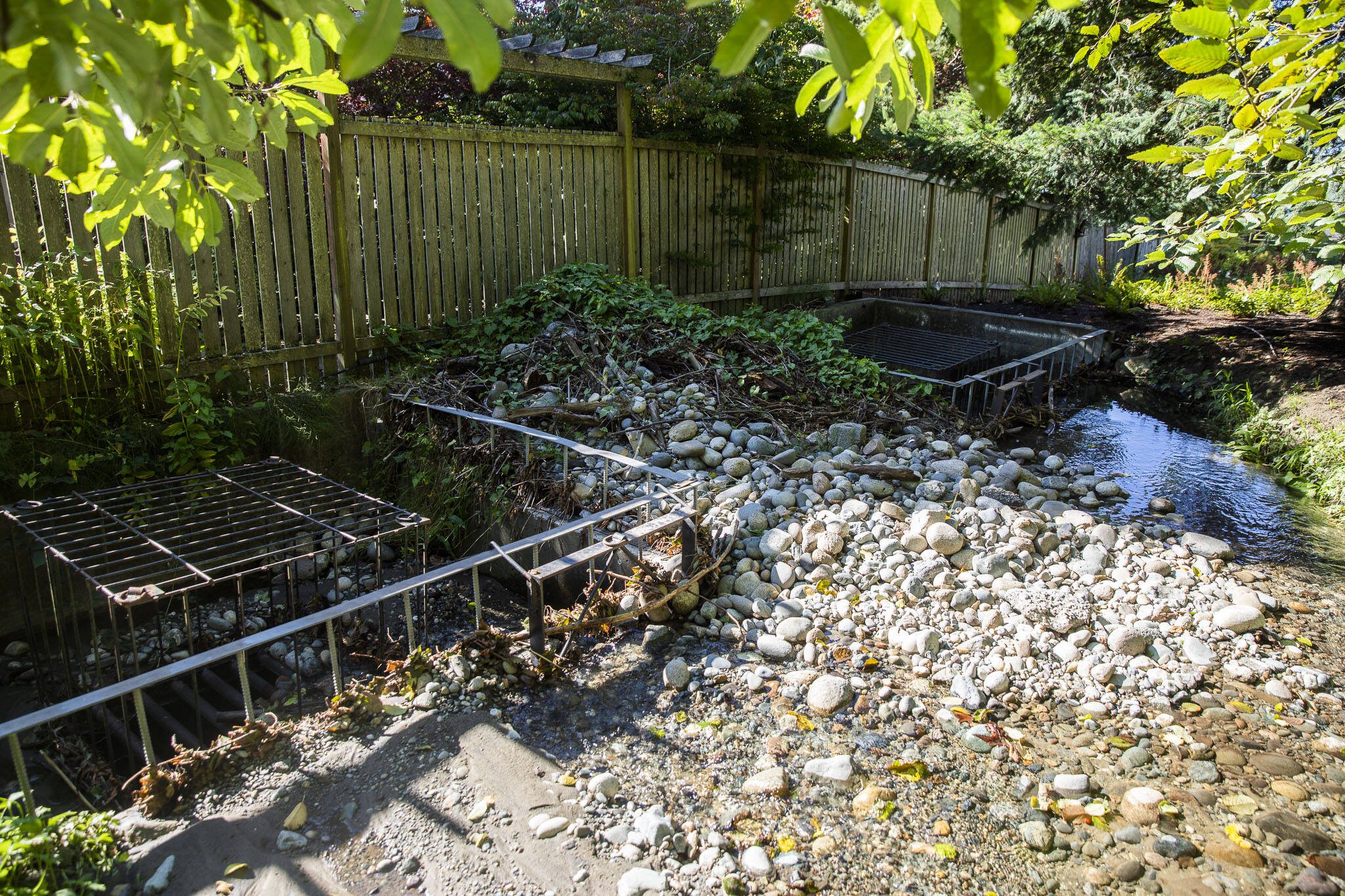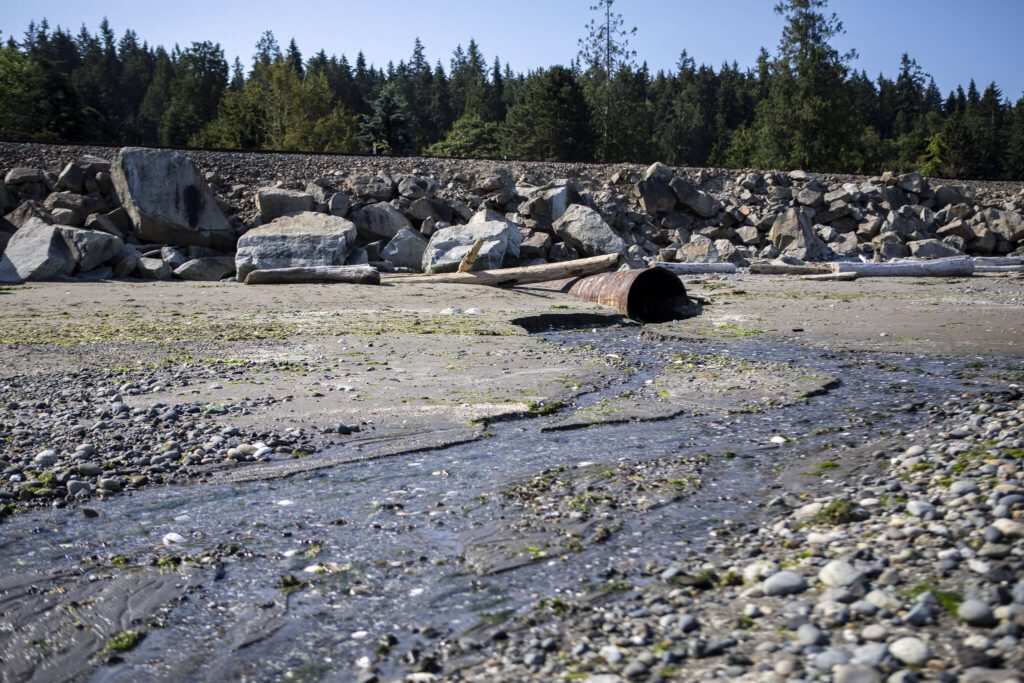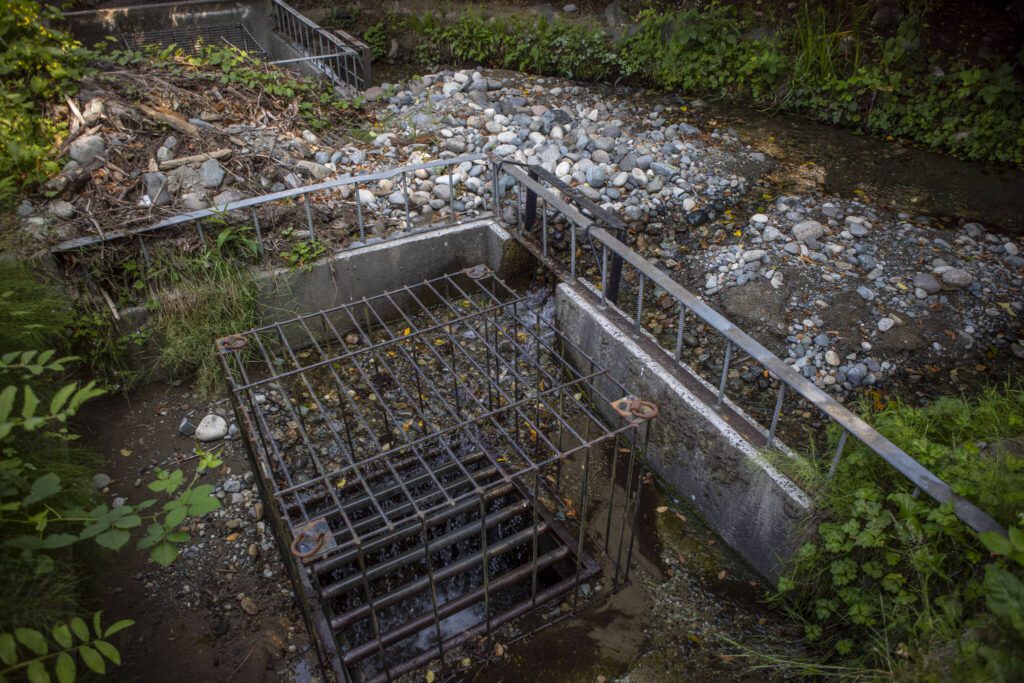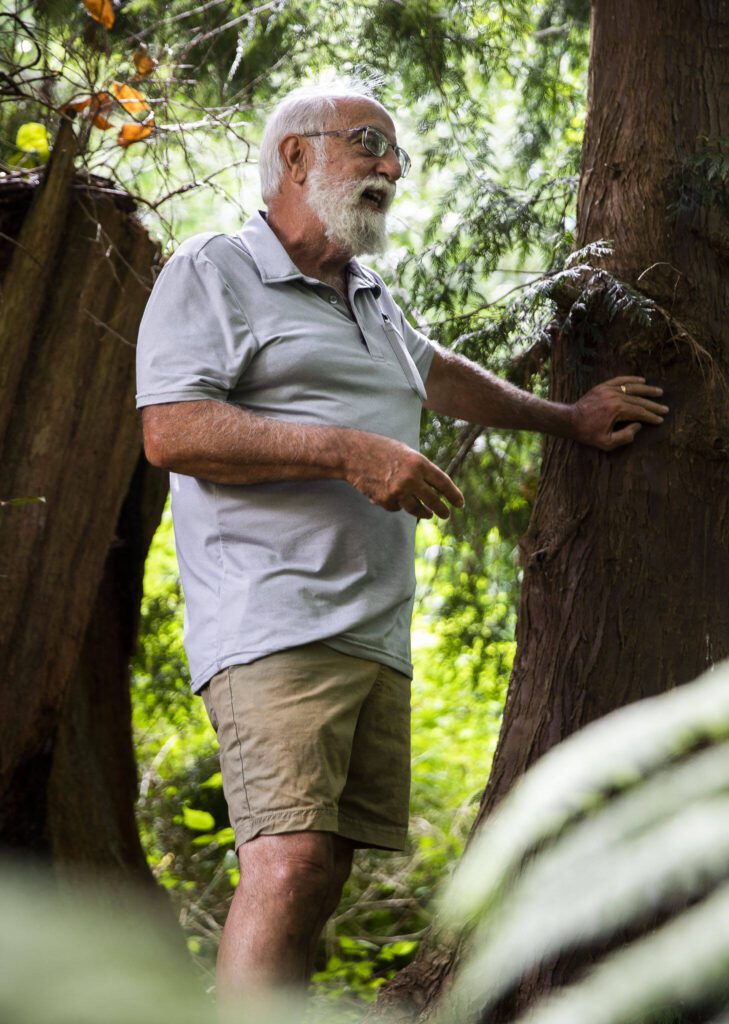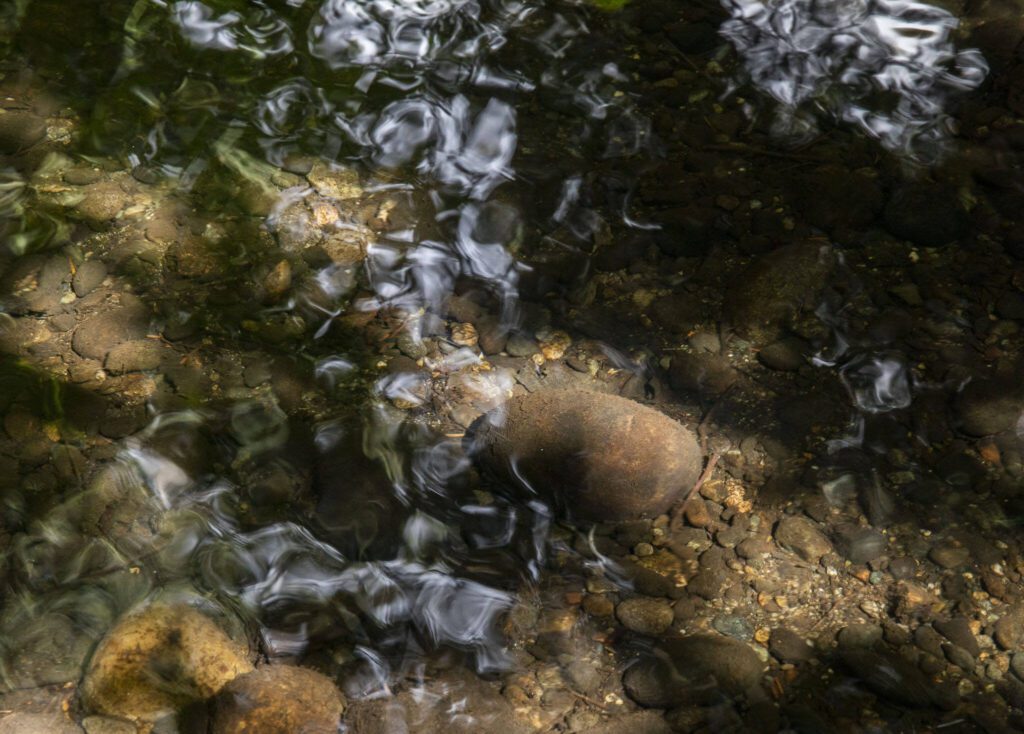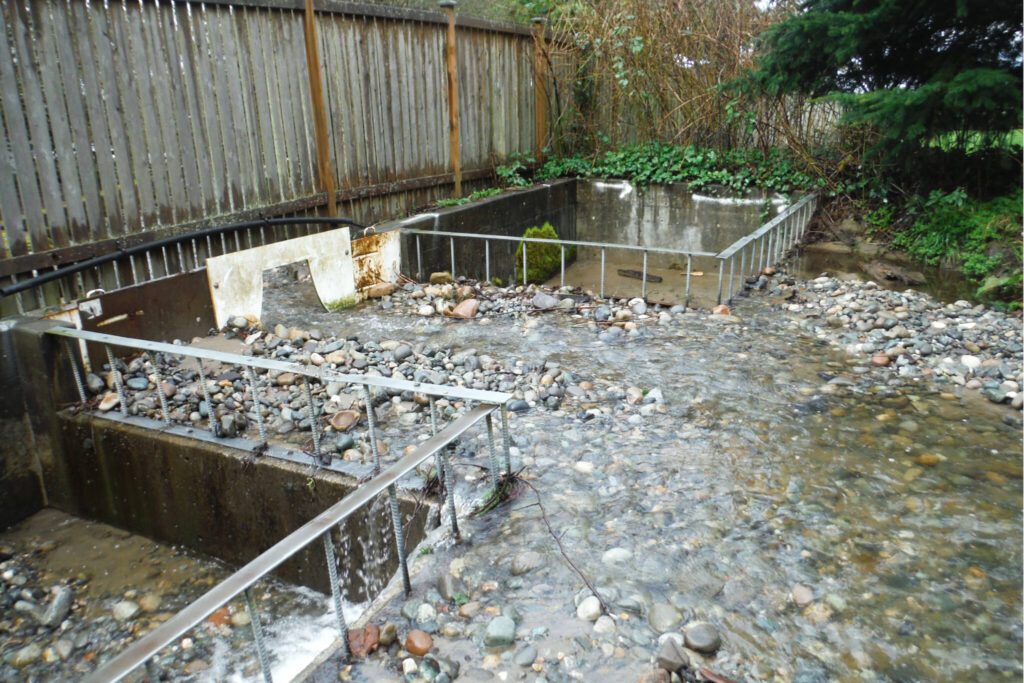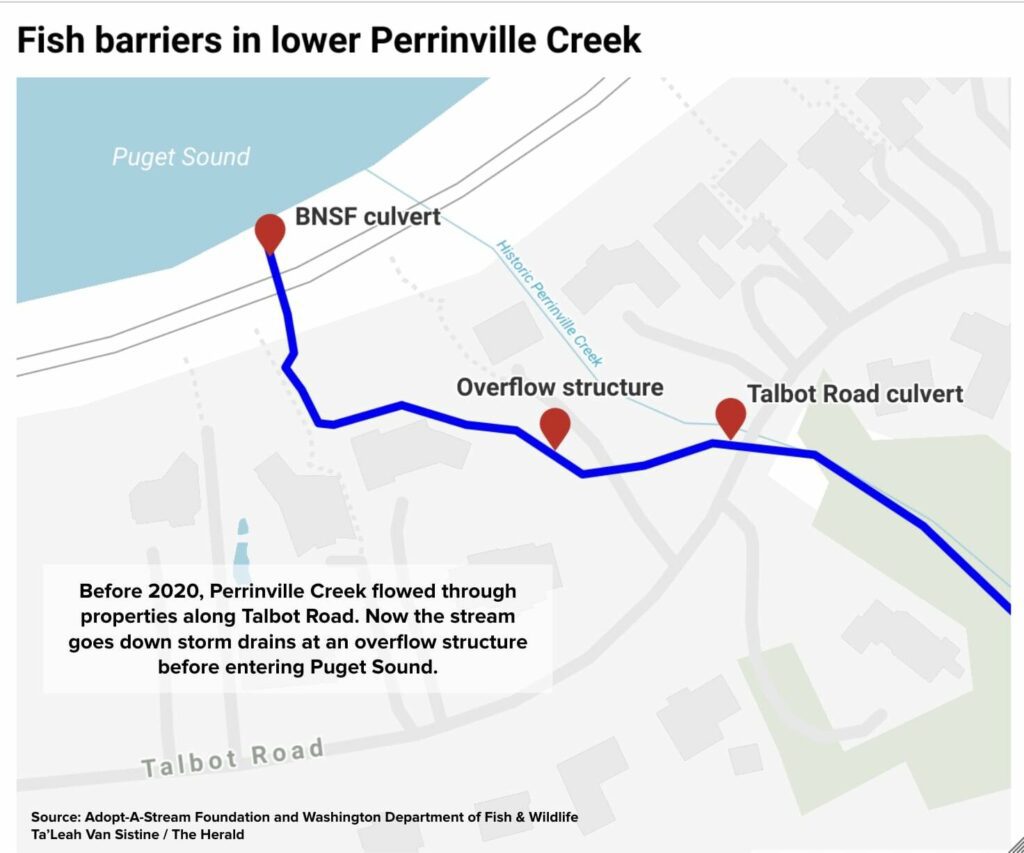EDMONDS — In 2026, hundreds of coho salmon will try to return to Perrinville Creek for spawning — like clockwork.
Over the past two years, with approval from the state Department of Fish and Wildlife, retired fishery biologist Joe Scordino and volunteers with the Edmonds Stream Team have released 8,000 coho fry in an upper stretch of the creek. Volunteers placed fish in other local creeks as well, with the larger goal of reestablishing salmon runs in small streams that coho, in particular, depend on for rearing and spawning.
Coho fry, at 1 to 2 inches with long parr marks on their sides, will spend their first year of life in a portion of Perrinville Creek that starts near the post office on Olympic View Drive, winds through Southwest County Park and flows into storm drains near Talbot Road before entering Puget Sound from a culvert underneath the railroad tracks.
After that first year, the salmon will swim toward saltwater and forage for months in the ocean before returning home — bringing with them energy and nutrients that support the surrounding ecosystem.
But Scordino and others fear any adult salmon trying to come back will likely die in the process, unless several barriers are removed.
Decades ago, former landowners along Talbot Road altered the stream channel into a rough “L” shape without necessary permits. Around 1994, near the same properties, the city of Edmonds added two concrete boxes with storm drain bottoms, and a flow constrictor in the middle, to reduce flooding.
To local advocates, those boxes are fish killers.
“These fish go by scent,” Scordino said. “So they’re going to get the scent of Perrinville Creek in that iron pipe that goes under the tracks, they’re going to go up, and they’re going to come into this concrete box and think ‘Oh, all I have to do is jump.’ They’re going to bang themselves to death trying to get through that box. Some of them are smart and say, ‘I give up, I’ll go somewhere else,’ but we don’t know how many.”
For years, locals like Scordino have begged city officials to remove the boxes and other fish barriers in lower Perrinville Creek. This month, the city partnered with the state Department of Fish and Wildlife, the Tulalip Tribes, BNSF Railway and landowners for a funding opportunity that could help restore upstream salmon migration in Perrinville.
Across the state, agencies and tribes are working to remove hundreds of concrete and metal pipes that further diminish habitat for a fish vital to the culture, recreation and industry of the Pacific Northwest.
‘A never-ending process’
Tom Murdoch, executive director of the Adopt-A-Stream Foundation, first saw adult coho in Perrinville Creek in 1995.
Ginger Holser, a state Fish and Wildlife biologist at the time, asked him to investigate a culvert at Talbot Road to see if Adopt-A-Stream could build a fish ladder — essentially a series of concrete steps filled with water that salmon could hop up to reach the pipe and swim toward Southwest County Park.
“There were coho salmon swimming around down there that couldn’t go any further up,” he said.
The nearly 70-foot-long culvert, hovering about 3 feet above the creek, has a 5% slope, according to a Fish and Wildlife report. The pipe was too steep for a fish ladder, Murdoch said.
“Ginger and I actually grabbed a few of the coho salmon that were there by their tails and walked them across the road,” giving them access to upstream habitat, he said.
It is unclear when the city installed the culvert.
Around 1995, Murdoch reached out to Edmonds Public Works to see if he could partner with city staff on a grant application to replace the culvert with a bridge, but he said the city wasn’t receptive to the idea.
For the next few years, Murdoch continued to notice a few adult coho somehow bypassing the city’s concrete boxes — known formally as an overflow diversion structure — near Talbot Road before reaching a standstill at the culvert.
Perrinville Creek’s restoration advocates are unsure when adult coho were last spotted in the stream.
After the city installed the concrete boxes, Public Works had to send crews out to Talbot Road a couple times per year to scoop out debris that piled on top of the drains, said Public Works Director Phil Williams. City staff worried Talbot Road would flood if they didn’t clear it out.
Crews use electroshocking to stun sea-run cutthroat and resident trout upstream of the overflow structure and collect them from the surface before removing the sand and gravel by hand or suctioning it out with sewer trucks. Staff then put the fish back and load the material in dump trucks, transporting it to a soil disposal site or project that needs structural fill, Williams said.
That material should have continued downstream into Puget Sound, Murdoch said, to provide habitat for marine life.
In 2012, city Public Works connected a pipe to one of the concrete boxes to reroute stormwater runoff from 125 acres of development, in an effort to reduce flooding on private property.
Over time, maintaining the boxes became “a never-ending process,” Williams said.
“It seemed like every rainfall we got, if we got over — I don’t know — a half an inch of rain, we’d have that box full,” he said. “We’ve had times when we went in and cleaned it out. And it rained two days later, it was full again.”
In late 2020, sediment completely blocked the concrete boxes, as well as the flow constrictor, during multiple significant storms. In one “dangerous and hideous exercise,” crews worked through the night to clear out the debris, Williams said.
The crew rerouted the stream down the boxes’ storm drains and blocked the flow constrictor that salmon had historically swam through.
After the storm, state Fish and Wildlife sent a letter to the city, reminding staff they needed permission to reroute the stream.
“But when you’re standing out there with a pair of boot waders on up to your chest at two o’clock in the morning, it’s not exactly something you’re going to be able to get permission from WDFW on,” Williams said. “Now we know that. We viewed it as an emergency. I still believe today it was the right thing to do, but hindsight is always 20/20.”
In 2022, Edmonds City Council approved a nearly $1 million contract with Environmental Science Associates to design a project that would remove the BNSF and Talbot Road culverts and possibly decommission the concrete boxes. But the city halted that work. The city didn’t respond to requests for comment this week about why it stopped the project.
“Our heart is definitely in the right place here,” Williams said. “It is not something we’ve ignored. We spent a lot of money, we’ve spent a lot of time, hired a lot of consultants. It is just a really difficult problem to fully resolve.”
‘Our situation isn’t unique’
This month, the Tulalip Tribes will apply for a $30 million federal grant for work to improve salmon habitat in Perrinville Creek and around 20 other streams along Puget Sound.
If approved, the tribes would allocate over $1 million to restoring lower Perrinville Creek by replacing the culvert underneath the railroad with a bridge and reworking the channel in a way that provides space for fish and limits flooding.
Project partners would also use the grant to draw up new designs for the stretch of creek near Talbot Road, allowing the city to remove the concrete boxes and the culvert under the street.
Edmonds Mayor Mike Rosen signed an agreement this month pledging the city’s support for the grant within the Federal Highway Administration’s Aquatic Organism Passage program.
Rosen declined requests for comment this week.
In the meantime, the city submitted an application to state Fish and Wildlife for another permit that would allow city crews to continue scooping out debris from the boxes. The city’s last permit expired in February.
Since 2018, the Tulalip Tribes have worked with BNSF to identify and remove culverts underneath the railroad tracks. Railway staff installed many of the culverts decades ago to manage coastal stream flows and strengthen rail infrastructure.
Over 100 of these culverts along Puget Sound restrict fish passage for adult salmon trying to migrate upstream. The pipes also eliminate nearshore habitat for threatened Chinook seeking refuge along the shoreline as juveniles before growing and wandering out into the ocean.
Loss of salmon habitat is loss of culture, said Todd Zackey, field studies program manager for the Tulalip Tribes.
Snohomish County’s work at Meadowdale Beach Park is a successful example of preserving what are called “pocket estuaries,” Zackey said, where fish can more easily travel in and out of stream channels.
Last year, the county completed the nearly $20 million project, in collaboration with the tribes and BNSF, to replace a 6-foot wide culvert underneath BNSF railroad tracks with a bridge that has a 100-foot opening beneath it.
Last spring, the Tulalip Tribes reached out to the city, landowners along lower Perrinville Creek and Fish and Wildlife about the potential to partner on the federal fish passage grant.
“We can’t do any of this restoration without partnerships,” Zackey said. “If we can get this funded, we can move forward.”
The grant would support the removal of a 3-foot wide, 53-foot long culvert underneath the railroad and installation of a bridge up to 32 feet long in its place, Zackey said.
Landowners Christi and Todd Flynn, and Charles and Jacque McLaughlin, have seen the creek distribute piles of sediment, rocks and other debris onto their properties during intense rainstorms. The culvert replacement under the BNSF tracks “is the cornerstone piece for a rehabilitated Perrinville Creek,” the homeowners said in a statement to The Daily Herald.
“As homeowners, our situation isn’t unique,” they wrote. “There are many creeks that flow into the Salish Sea through private property and under the BNSF railroad tracks. Many homes were built decades ago (as our homes were) and with the continued land development upstream and more impervious surfaces, there is more stormwater entering the creek systems.”
“We support a long-term solution for the creek’s restoration that would reestablish the habitat for the fish,” the homeowners continued in their statement, “rather than a band-aid fix approach.”
‘Harsh environment’
In 2012, Lynnwood-based civil engineer Bill Lider first inspected the culvert where Perrinville Creek feeds into Puget Sound.
He had been hearing concerns from locals about fish migration barriers in the stream.
On the beach, the pipe is rusted and has holes.
“At that time, I said it needs to be replaced soon, in so many words,” Lider said.
He sent multiple letters to the city, encouraging staff to take a video inside the pipe.
The city sent in a crawler camera last July, revealing ballast rock — gravel used to support railroad tracks — protruding through the top of the pipe. The hole is big enough for the rock to drop right through, Lider said.
“You can expect that the pipe under the railroad tracks would be in the same kind of condition,” Lider said. “This is a really harsh environment that the pipe is in and out of salt water twice a day … and so the corrosion has been going on.”
The pipe is undersized and structurally deficient, he said, for fish passage and massive stormwater flows.
In 1998, multiple consultants examined Perrinville Creek’s channel for the city and found “the erosion by Perrinville Creek, if left unchecked, poses a threat to homes, to Talbot Road and to the Burlington Northern Railroad.”
Lider worries if the city doesn’t replace the pipe soon, it could collapse.
But Williams, the Public Works director, said, “We’re not really that concerned about that.”
“BNSF has inspected the culvert on a number of occasions, and it is structurally sound,” BNSF spokesperson Lena Kent wrote in an email.
This summer, Lider encouraged city staff to prepare an Environmental Impact Statement for Perrinville Creek, in light of the city’s application to continue maintaining the concrete boxes near Talbot Road.
In doing so, Lider believes the city can determine who is responsible for creek restoration, evaluate alternative solutions and costs, come up with a realistic project schedule and consider safety risks associated with continued maintenance of the concrete boxes.
‘Give them a chance’
Eradicating the fish barriers in lower Perrinville is only the first step toward restoration, said Scordino, the retired fishery biologist.
The city will still need to address erosion and high flows where the creek passes the post office on Olympic View Drive. A nearby culvert, and a continuing maze of pipes, prevents fish from going further upstream.
“When there’s heavy rain, that pipe is like a fire hydrant being opened,” Scordino said. “It’s just this huge gush of water coming out.”
Even ½-inch rain events send a torrent of sediment down the creek, as the channel travels at a steep decline until it reaches the floodplain at Talbot Road, where it all accumulates at the concrete boxes.
“Fish for centuries have dealt with high and low flows,” Scordino said. “What they haven’t figured out how to deal with is when you have this artificially high flow that knocks all this sediment down — it just fills in their whole habitat.”
Scordino expects about 10% of the 8,000 coho he and volunteers released in Perrinville Creek will try to return in two years.
He hopes the young salmon will boost local coho populations and highlight successful habitat in the stream’s upper stretch as the fish grow and thrive — even if they aren’t able to come home in the future.
“These fish are really resilient — give them a chance,” he said. “That’s kind of the problem with recovery of salmon is we’re not giving them the chance. They’ll come back if you give them the chance.”
Former Herald reporter Aina de Lapparent Alvarez contributed to this report.
Ta’Leah Van Sistine: 425-339-3460; taleah.vansistine@heraldnet.com; X: @TaLeahRoseV.
Talk to us
> Give us your news tips.
> Send us a letter to the editor.
> More Herald contact information.
